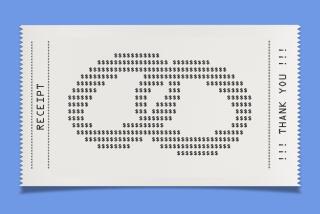Crisis Management : A Strict Spending Plan Should Help Rescue the Coopers
- Share via
The Coopers’ lives once seemed so bright they needed shades.
The hard-working couple made nearly $100,000 a year. Michael and Stephanie often spent Saturdays at the mall buying clothes and toys for their daughters, Jourdan, now 3, and Kendall, now 15 months. They took weekend trips to Las Vegas. They bought brand-name grocery items and the best cuts of meat.
Two years ago, the Coopers moved into their dream home in Carson, in the same neighborhood where Stephanie grew up. She wanted her daughters to have the kind of safe, happy childhood she had had, but better. Their three-bedroom house was only five minutes from Stephanie’s mother’s house, where the couple had lived for a year in order to save enough for a down payment on a home of their own.
But somehow it all went wrong.
Michael, 33, and Stephanie, 31, are now on the verge of filing for bankruptcy protection. They are $1,400 behind in debt payments. Their monthly take-home pay of $4,358 is barely enough to cover bills and living expenses of $4,188 a month.
They face tough decisions, such as whether to walk away from their home, in which they have no equity, raid their 401(k) plan or sell the family car.
How did it happen? As with many Southern Californians, the Coopers were living way beyond their means. Their lifestyle was supported by a foundation of debt, the minimum payments on which they could barely make when they were pulling in $100,000.
But then the couple decided Stephanie’s $54,000-a-year job wasn’t worth the long commute and long hours away from home. In February, she took a job managing artists’ and performers’ careers that was closer to home but that paid $33,000 a year.
That’s when the problems really began mounting.
Now about two-thirds of their income goes to make minimum payments on their debts. About a third of their income goes to pay housing costs that include home insurance, a gardener and first and second mortgages on their house, which they bought for $176,000. As their mortgage payments have absorbed an increasing amount of their income, the couple got further and further behind in payments on their other debts.
“There are so many bills out there now and we can’t cover them,” Stephanie said. “It’s created a lot of stress. There were times we thought it would boil over, but we realized the important thing was for us to hang together as a family.”
Two things the Coopers are determined to do. First, they are not going to lose each other or their marriage. Second, they say they aren’t going to lose their house. They told certified financial planner Darlene Jacobsen, who reviewed their finances, that they will do whatever it takes to keep their home.
“I don’t want my children to grow up in an apartment,” said Michael, who makes $36,000 a year as a radio production engineer and $8,400 more by doing additional engineering work on the side. “I love my wife and I love my family, and I don’t want to lose them over this.”
Although the situation seems overwhelming, it’s actually not unusual, said Jacobsen, based in Corona del Mar. Many families of all income levels are drowning in debt. Even families such as the Coopers, who still make about $75,000 a year, can get into trouble.
*
Jacobsen pointed out that there will be no quick fixes for the Coopers but that they are committed to extricating themselves from the situation, and a steadfast commitment is what it will take.
Debts that take years to build up will often take at least as much time to get rid of, Jacobsen said. The challenge for the Coopers will be to hold on to their dream house while they do it.
“It usually gets worse before it gets better,” Jacobsen warned of situations such as theirs. “Even if you follow a strict spending plan for two years, you are going to have some tough times ahead.”
This is what the Coopers are facing: They have borrowed from Michael’s 401(k) plan, which has about $7,000 remaining, to stay current on their first mortgage. They are behind two payments totaling $600 on a $20,000 second mortgage with a high interest rate.
They have $15,800 of debt on a personal line of credit used to pay down credit card balances and to make home improvements. The couple pay $200 a month on that loan and are behind four payments.
They have stopped using their credit cards, but they still owe about $5,100 on six cards. There is also a personal loan for $2,005 that has a $240 monthly payment. The couple pay $50 a month on a $1,452 student loan and $50 a month on $943 in back state taxes.
Their 1988 Chrysler LeBaron convertible is paid for, but it needs some repair work. The couple have already spent $5,000 in repairs this year. They pay $416 each month to lease a 1993 Jeep Cherokee whose lease expires in June.
Solving problems like these isn’t easy, Jacobsen said. But the Coopers do have some options they can consider.
Jacobsen advised that bankruptcy is not the best choice, although it can seem like a way out for families who feel their backs are against the wall. The couple would still face the loss of their home, she said, albeit later rather than sooner, and their credit would suffer serious long-term damage.
A better scenario, Jacobsen said, is for the Coopers to deal with their debts on a case-by-case basis and create a two-year spending plan designed to help them emerge from their crisis.
First, the couple is to be commended for staying up-to-date on their first mortgage, but they urgently need $600 to catch up on the second mortgage and $800 more to catch up on their line of credit. If those payments aren’t made soon, Jacobsen warned, they could face foreclosure and wage garnishment.
What the couple need is a chunk of change to make those payments.
They should sell the Chrysler LeBaron immediately, which should bring about $4,500. That money should be put into a special reserve account. To get current on the second mortgage and line of credit, $1,400 can be withdrawn to make back payments. So Stephanie can get to work, they can take out about $1,300 and rent a car for the next three months. Their automobile club membership will allow them a 10% discount for a rental car, the planner noted.
Jacobsen doesn’t think Stephanie should try to get her higher-paying job back, as she and Michael think it’s important for her to spend more time at home. But Michael should be able to boost his $700 a month in extra income to $1,000 in the next three months, Jacobsen said. Jacobsen notes that since Michael says he is able to pull in $700 without much effort, some increased attention to his side jobs should meet that goal without much difficulty.
That extra money will go directly into the reserve account, which will give the couple at least $4,600 in three months. (Extra income from cost-cutting measures outlined below will also go into the reserve, beefing up the amount to nearly $5,600 in three months.)
At that time, the couple could spend $2,000 on an older car that would be used only for Stephanie to get to work. Once that is done, the couple should consider turning in their Jeep Cherokee for a car whose monthly payments will be much lower than the lease charges.
Now for the strict spending plan. The couple are spending only $175 a month on food because they clip so many coupons, but there are ways they can save further.
Their living expenses include gas and electricity, $100; phone, $70; water, $20; cable TV, $35; gardener, $50; auto insurance, $115; gasoline, $100; cellular phone, $40; day care, $600; pager, $25; and entertainment, $50.
Jacobsen advises cutting the phone bill to $50 and getting rid of the gardener and cell phone. That will give them an additional $110 a month for the reserve account.
*
But most important, the Coopers must change their attitude toward money. For example, the couple spent $1,500 on Christmas last year. That can’t happen again, the planner said.
“The greatest gift you could give yourselves and your friends and family this year is to stop spending,” Jacobsen said.
Because Michael works long hours, Stephanie has been handling most of the couple’s finances. It is common in marriages for one person to handle money matters, Jacobsen said, but it’s a bad idea in the long run.
The Coopers need to work together when it comes to money. Jacobsen advises that twice a month the couple have what she calls a “money date,” complete with candles and wine. That time, which should be after the kids go to bed, is for the couple to go over their bills and household finances together.
More advice: Pay bills at the same two times every month--agreed-upon dates near the first or 15th. The couple have been spending too much energy juggling to meet deadlines, and such habits lead to late payments, Jacobsen said.
As for reducing credit card debts, the couple should be able to attack those more aggressively once Michael’s freelance income rises. If he can continue to make an extra $1,000 a month, they should commit $500 of the monthly reserve money to paying off credit cards, going after those with smaller balances or higher interest rates first.
In addition, the couple should start “paying themselves first”--that is, putting 5% of their income into a money market account that will eventually go toward retirement savings. That amount should be increased to 10% after they’ve been on a strict budget for two years.
Their reserves could be in either a checking account or a bank money market account, Jacobsen said. In the meantime, the couple should continue trying to put $25 every month in an account for each daughter, something they do sporadically now. That money is being matched each month by Stephanie’s mother. In five years, when their situation improves, they should increase the amount to $100 a month for each girl. By the time the older girl is ready for college, the Coopers should have $40,282 invested.
They also urgently need life insurance so their daughters will be taken care of should anything happen to the parents.
If they follow this plan, within two years the couple should have a reserve of between $6,000 and $12,000 and be out of their cash crisis.
But the toughest part for the Coopers will be getting through the next six months as they work to stabilize their finances. Success there is critical to the whole plan.
After that, Michael should begin putting the maximum amount he can into his 401(k), and Stephanie should set up a separate retirement account.
The couple need to remember that what they are going through can be physically, mentally and emotionally draining, said Jacobsen. They need to take care of each other as they work through the tough years ahead, she said.
“We just want to get out of the quicksand we are in now,” Stephanie said.
(BEGIN TEXT OF INFOBOX / INFOGRAPHIC)
This Week’s Make-Over:
Investors: Michael and Stephanie Cooper
Occupations: Production engineer and talent manager
Ages: Michael, 34; Stephanie, 31
Expected annual income: $75,000
Primary financial goal: Get out of debt without losing home
*
Current status:
Monthly income: $4,358
Monthly expenses: $4,188, including living expenses
Housing debt:
First mortgage: $158,000
Second mortgage: $20,000
Personal debt:
Personal line of credit: $15,800
Credit card debt: $5,100
Student loans, taxes and other debts: $5,225
*
Recommendations:
There are no quick fixes to a debt problem of this magnitude, but here is how the Coopers can start:
Live within their means
* Return leased Jeep Cherokee and get a car with much lower payments.
* Get rid of cellular phone and gardener; reduce phone bill.
Get financial protection for the children
* Spend $79 a month for life insurance for two children.
* Continue putting aside $50 a month for children’s college.
Reduce current debt pressures
* Sell Chrysler LeBaron immediately.
* Set up a separate reserve account with expected $4,500 from the car’s sale.
* Pay $1,400 in delinquent second mortgage and line of credit payments with money from the car.
* Spend two nights a month to go over bills, and pay them on same two dates every month.
* First six months, continue making minimum payments on credit cards. In six months, increase amount to $500 a month.
* In one year, renegotiate second mortgage for lower interest rate.
Build reserves
* Expected extra $1,000 a month income from Michael’s side jobs goes into reserve account; don’t withdraw unless an emergency.
* Follow that strict budget. Shop secondhand.
Are You in Over Your Head?
The Coopers, like many people overburdened with debt, might have avoided their misery had they better seen the warning signs of debt overload. Here are those warning signs, as provided by Los Angeles Consumer Credit Counseling Services ([800] 388-2227):
* Pervasive worry about money
* Fighting with spouse about money; (80% of divorces are linked to money problems)
* No savings
* Living from paycheck to paycheck; (is the month longer than your money?)
* Debts add up to 20% or more of income; (add up all monthly debt payments, excluding first mortgage, and divide into net income; the percentage should not exceed 20%)
* Using credit cards for basic living expenses, such as groceries
* Making only minimum payments on your debt
More to Read
Inside the business of entertainment
The Wide Shot brings you news, analysis and insights on everything from streaming wars to production — and what it all means for the future.
You may occasionally receive promotional content from the Los Angeles Times.










